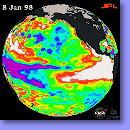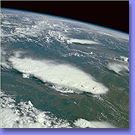E L N
I Ñ O / L A N I Ñ A
 El
Niño
El
Niño
The term El Niño (Spanish for "the little boy" or
"the Christ Child") was originally used by fishermen along the coasts of Ecuador
and Peru to refer to above-normal sea-surface temperatures that typically appear
around Christmas time in the eastern Pacific Ocean and last for several
months. But El Niño's effects are not limited to Peru and Ecuador.
They can impact weather patterns around the world, and the
disruption of the normal climate can have profound and even tragic consequences.
How Does El
Niño Work?
In normal years, winds tend to blow from east to west across
the waters of the tropical Pacific. The easterly winds (remember that wind directions
refer to the direction FROM which the wind comes: an easterly trade wind comes
from the EAST and blows WEST) push the surface waters westward across the ocean.
In turn, this causes deeper, colder waters to rise to the surface. This "upwelling"
of deep ocean waters brings with it nutrients that otherwise would remain near
the bottom. Fish populations living in the upper waters are dependent on these
nutrients for survival.
During
El Niño years, the winds weaken, reducing or even choking off the upwelling
of deep water. The consequent warming of the ocean surface further weakens the
winds and strengthens El Niño. As the Pacific continues to heat up, the
warmer waters shift eastward, and so do the clouds and thunderstorms that produce
heavy rainfall along the equator. This results in changes in jet
streams (the winds high aloft), which lead to dry conditions in Indonesia
and Australia, and floods in Peru and Ecuador. El Niño events occur on
average every 3 to 5 years, though there can be periods of up to a decade without
an El Niño.
 El
Niño's Effects
El
Niño's Effects
The 1982-83 El Niño was unusually strong. In Ecuador
and northern Peru, up to 100 inches of rain fell during a six-month period,
transforming the coastal desert into grassland dotted with lakes. Abnormal wind
patterns also caused the monsoon rains to fall over the central Pacific instead
of on the western shores, which led to droughts and disastrous forest fires
in Indonesia and Australia. Overall, the loss to the global economy as a result
of the El Niño amounted to more than $8 billion.
Likewise,
the winter of 1997-1998 was marked by a record-breaking El Niño event.
The result was unusual weather in parts of the world, including the U.S. Severe
weather events included flooding in the southeastern United States, major storms
in the Northeast, and flooding in California.
La Niña
El Niño's twin sister is La Niña ("the little
girl" in Spanish). Her effects are, as any siblings would expect, the exact
opposite of El Niño's: for instance, precipitation is below normal in
California and the southeastern U.S.! La Niña is characterized by below-normal
sea surface temperatures in the eastern equatorial Pacific. There are large
variations in weather for many U.S. locations from warm spells to cold waves
during a La Niña winter.
El Niño
and Global Warming: Any Connection?
Scientists still cannot say with certainty that global
warming is affecting El Niño events. In January 1999, however, scientists
at the National Center for Atmospheric
Research (NCAR) and elsewhere reported that global warming may accentuate
El Niño's current and future impacts. El Niño events have become
more frequent and have had greater climate impacts over the past century. This
change in El Niño events corresponds to a rise in global temperatures.
To see how El Niño and La Niña change North America's seasons,
check out WHEN.
(Adapted, with permission, from the ERA/NASA/NOAA
Climate Change Presentation Kit CD-ROM.) link to RESOURCES
Images provided
by NOAA

 El
Niño
El
Niño  El
Niño's Effects
El
Niño's Effects![[Normal Conditions]](images/normal.gif)